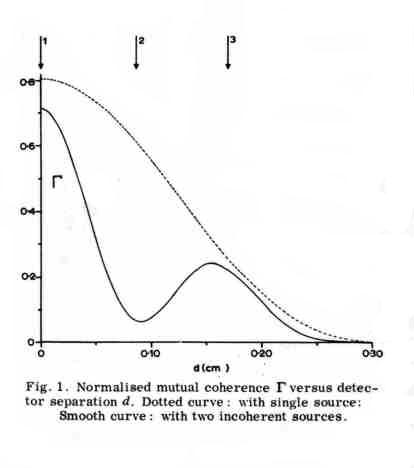Hanbury Brown famously measured the correlation between the intensities at two different points in the field produced by a small source of light.
Nigel Haig as a PhD student in Edinburgh built apparatus to perform a similar task, but the field under investigation was that from a pair of small uncorrelated sources of quasi-moonochromatic 'thermal' light. No visible interference effects could be observed, but some evidence for a spatial modulation in the mutual coherence pattern was found.

Photomultiplier tubes were used as detectors, and coincidences between their output pulses were counted, both for prompt coincidences and with a 15 ns delay cable in one channel. With the delay, which was about 30 times the coherence time of the light, coincidences occurred at random. Any statistically significant excess of 'prompt' counts over 'delayed' counts is a measure of the correlation.
Counting in each case was continued for many hours (or days) at each of the three positions indicated above the graph, recording about 20,000 coincidences on each occasion. Continuation of counting beyond this time yielded no improvement in the reliability of the results because of thermal variations in the performance of the electronic apparatus, despite the use of room thermostats and local lagging.
Table 1
N D Haig and R M Sillitto, An interference experiment with two independent thermal light sources, Physics Letters 28A 463-464, (1968)
|
|||||||||||||||
|
N D Haig and R M Sillitto, An interference experiment with two independent thermal light sources, Physics Letters 28A 463-464, (1968)
In the early 1970s, the department moved, in several stages, from Drummond Street to the newly-built James Clerk Maxwell Building (architect, Hardie Glover, of Basil Spence & Partners) on the King's Buildings campus, two miles to the south.
Some of Nigel's apparatus was re-assembled there, with better photomultipliers and faster electronics which recorded the random and the correlated coincidences simultaneously. Again, counting periods of many hours were required before the number of 'prompt' counts clearly exceeded the variations in the 'delayed' counts.
Joan McMillan optimized the process, and produced graphs for both green and blue light:

Normalized second-order correlation r versus detector separation.
l=546.1nm : smooth curve and diamond symbols
l=435.8 nm : dotted curve and square symbols
Joan L McMillan, R M Sillitto and Winifred Sillitto, Second-order coherence effects due to the superposition of two independent thermal light beams, Optica Acta 26 1125-1128 (1979)